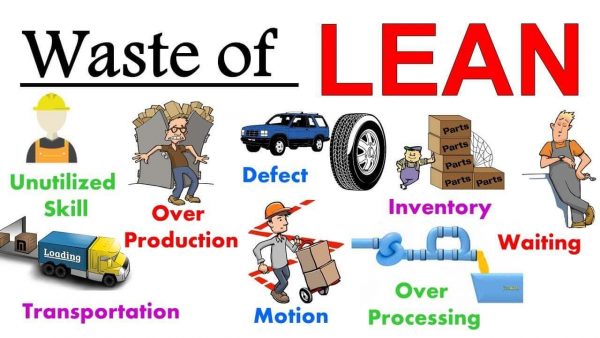What are 8 Deadly wastes of Lean Manufacturing ?
Eliminating Lean waste from System was suggested by the founding fathers of Lean manufacturing, Taiichi Ohno. Initially Taiichi Ohno identified 7 types of wastes, later on 8th waste of Unutilized skills was added to this list.
The ultimate aim of Lean is to reduce waste from process. So before we deep dive in to what are these 8 deadly wastes of Lean manufacturing, lets first understand what is “Waste” which is also referred to as Muda.
Anything that doesn’t increase / add value in the eye of the customer is a Waste. In other words, we like to say that when value added work is done, the “form, fit or function” of a thing is changed. It can be in the form of cost, time or resources. Waste is just a symptom and we need to find the root cause of these waste so that we can eliminate these waste from the system. Waste is considered to be any part of the process that takes time and resources but add no or very little value to the final product. In Lean terminology we call it “Muda“. The best way to understand this concept of waste is by putting yourself in customer shoes and asking yourself, Would you pay for these non-value added activities or wastes?.
That is why someone refer to it as 7 Waste of Lean Manufacturing and some as 8 Waste of Lean Manufacturing . Every effort should be made to reduce all these deadly waste of Lean manufacturing. So everything that is done in the company is divided into two groups: Value added and Non Value added.
Lean identifies 8 different types of wastes which can be remembered as acronym “DOWNTIME” which are first letter of each of these 8 waste. In the “DOWN”, it consists of defects, overproduction, waiting, and non-utilized talent while in “TIME”, there are transport, inventory, motion, and excess processing.

Now, let’s take a look one by one. Starting from defect.
1) Defect:
1st type of waste is Defect: Defect can be an abnormality that is not fit for use or is rejected by Customer. It will result in re-work which ultimately leads to increase cost to the company. These defect can be internal or external. Some of these defects can be reworked while others are scraped. So if defects are there in the system or process, then it can lead to additional space, time, logistics, and even manpower to deal with it.
2) Over Production:
2nd type of waste is Overproduction which means producing more than desired by end customer. The main reason of over production is generally poor production planning and uneven demand from customer, which forces company to produce more than desired and keep the extra production in Inventory. The effect of this overproduction waste will lead to inventory excess, and then finally the high inventory cost of storing these products.
3) Inventory:
3rd type of waste is Inventory which means storing raw materials, work in process or finish goods beyond that is immediate need.
4) Waiting:
4th type of waste is Waiting. Anything where some ideal time is generated because some downstream/ upstream is waiting for next action. Like waiting for raw material or equipment. Its mainly if your assembly line is not balanced properly. This will lead to longer and longer queue, which means higher waste and higher cost . This types of wastes if often less visible than in comparison to Overproduction and Inventory.
But of course, this waste of waiting can be tackled with the workload balancing. Watch this YouTube video on How to balance a assembly line. You can use other tools like TPM (Total Productive Maintenance) or SMED (Single Minute Exchange Dies) to reduce the waiting time
5) Not utilizing talent:
5th type of waste is Not utilizing 100 % resources.
6) Transportation:
6th type of waste is Transportation which is nothing but unnecessary movement of people, machines, tools, raw material, work in process or finish goods from one location to another.
7) Motion:
7th type of waste is Motion: which is about the unnecessary movement of people, machines, Tools without adding any value to the final product or service.
8) Excess processing:
8th type of waste is Excess Processing: Additional process steps or features that does not add any value to end customer or adding process steps that is far beyond the expectation of the customer.
I hope this blog helped in understanding the basic concept in a simplified manner, watch out for more such stuff in the future.
📢📢 𝑺𝒐𝒄𝒊𝒂𝒍 𝑴𝒆𝒅𝒊𝒂 𝑳𝒊𝒏𝒌:
Thanks!!!
For questions please leave them in the comment box below and I’ll do my best to get back to those in a timely fashion. And remember to subscribe to Digital eLearning YouTube channel to have our latest videos sent to you while you sleep.
✍️ 𝓓𝓲𝓼𝓬𝓵𝓪𝓲𝓶𝓮𝓻: Copyright Disclaimer under section 107 of the Copyright Act of 1976, allowance is made for “fair use” for purposes such as criticism, comment, news reporting, teaching, scholarship, education and research. Fair use is a use permitted by copyright statute that might otherwise be infringing. The information contained in this video is just for educational and informational purposes only and does not have any intention to mislead or violate Google and YouTube community guidelines or policy. I respect and follow all terms & conditions of Google & YouTube.





